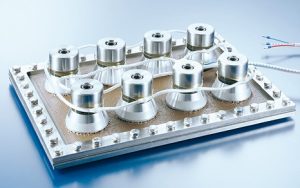— Ana Luisa Maria, University of Torino, Arkema
Ultrasounds is an emerging technology with many applications in different industrial sectors as Ekim Sarac explains meticulously in her blog.
Weber Ultrasonics based in Germany, rises from the necessity of innovation in industrial application spectrum of ultrasound technology. The company is focused on the development of potential uses and processes by expanding ultrasound know-how.
Founded in 1998, Weber Ultrasonics has three different sectors: cleaning, welding and cutting.
Cleaning
Ultrasonic cleaning allows the rapid and complete removal of contaminants from objects which are immersed in a tank of liquid that is flooded with a certain frequency sounds waves.
The ultrasonic energy enters in the liquid within the tank or bath causing the rapid formation, growth and collapse of bubbles (cavitation). These bubbles travels at high speed within the tank, causing them to implode against the surface of any immersed object with an enormous release of energy. As the bubbles implode and cavitation occurs, the surface of an object is cleaned. Different frequencies are applied to different cleaning treatments1.
Weber Ultrasonics develops ultrasonic generators (Figure 1) for industrial cleaning suitable for different purposes. From 25 to 132 kHz – automotive components for zero-defect downstream processes, jewelry, optical components or medical devices. From 250 to 1000 kHz – delicate components like monocrystalline photovoltaic wafers, micro-systems technology and Nano technology2.

Figure 1: Sonoplate transducer
Welding
This sustainable clean technology requires no additional materials (adhesives) making it the perfect tool for welding materials.
In this technology, ultrasound converts the electrical signal from the generator into the mechanical vibrations. These in turn are directed to the workpiece to be welded via the booster and the sonotrode pressure. The mechanical vibration generates frictional heat at the defined joints of the workpiece, causing the melt of the material, bonding the parts together. During a brief cooling phase, a clamping force is applied to fuse the plasticized material. The pieces welded together with ultrasonic energy are immediately available for further processing. Depending on the materials the sonotrodes can weld vertically, horizontally and continuously (Figure 2)3.

Figure 2: 1 – embedding, 2 – cycled welded, 3 – embossing, 4 – perforating, 5 – laminating
Cutting
What about food?

Yes they do…
Movement amplitudes of a few micrometres are generated at the tool blade reducing process forces. The frequency and the oscillation mode are determined based on the tool properties. The system is then operated at this resonant frequency. As a result, the degree of efficiency of the ultrasonic support increases up to 95 per cent and the process forces are significantly reduced.
Weber Ultrasonics cooperates with the COSMIC project providing a deep knowledge to the associates about the ultrasonic field as well brainstorming to achieve a continuous ultrasonic success!
During the secondment that I pursued in the company, I was surprised by this open-mind creative company. Always available to discuss the right equipment to apply in the development of my project. Weber Ultrasonics is with no doubt a pleasant company to work with.
Take a look at their site!
https://www.weber-ultrasonics.com/
- Ensminger, D. Ultrasonics: Fundamentals, Technology, Applications, Second Edition, Revised and Expanded. Taylor & Francis: 1988.
- Cleaning – Weber Ultrasonics. https://www.weber-ultrasonics.com/en/reinigen/.
- Welding – Weber Ultrasonics. https://www.weber-ultrasonics.com/en/schweissen/.




